Bay Islands Department
The Bay Islands (Spanish: Islas de la Bahía; pronounced [ˈislas ðe la βaˈi.a]) is a group of islands off the coast of Honduras. Collectively, the islands form one of the 18 Departments of Honduras. The departmental capital is Roatan, on the island of Roatán.
Bay Islands Department Departamento Islas de la Bahía | |
|---|---|
 Bay Islands Department  Bay Islands Department | |
| Coordinates: 16°17′27″N 86°24′39″W | |
| Country | |
| Municipalities | 5 |
| Villages | 23 |
| Founded | 14 March 1872 |
| Capital city | Roatan |
| Government | |
| • Gobernador | Dino Giovanni Silvestri Molina (2018-2022) (PNH) |
| Area | |
| • Total | 229 km2 (88 sq mi) |
| Population (2015) | |
| • Total | 65,932 |
| • Density | 290/km2 (750/sq mi) |
| Time zone | UTC-6 (CDT) |
| Postal code | 34101 |
| ISO 3166 code | HN-IB |
| HDI (2017) | 0.631[1] medium · 4th |
| Statistics derived from Consult INE online database: Population and Housing Census 2013[2] | |
The total surface area of the islands is 250 km2. In 2013, they had an estimated population of 71,500 people. The islands comprise three separate groups:
- Swan Islands, the most northerly
- Islas de la Bahía (with the main islands Roatán, Guanaja and Útila, and numerous satellite islands) 120 km to the south
- Cayos Cochinos, further south
Geography
The Bay Islands consist of eight islands and 53 small cays lying 15 kilometres (10 mi) to 60 kilometres (40 mi) off the northern coast of Honduras. These islands have been administered as a department of the Republic of Honduras since 1872.[6] Located on the Caribbean Sea, not far east of the entrance to the Gulf of Honduras, they are clearly visible from the mountainous mainland.[7] The group is made up of the three large islands, Utila, Roatan, and Guanaja, and the smaller islands, or island groups, St. Helena, Barbareta, Morat, and, closest to the mainland, the two Hog Islands (Cayos Cochinos).[7]
Roatan is the largest with a length of about 60 kilometres (40 mi)[8] and a maximum width of 14 kilometres (9 mi) at its widest point. Roatán, is characterized by its mountainous backbone, composed of hilltops that run west-to-east across the entire island. These hilltops are often crowned by outcrops of exposed metamorphic rocks such as marble, amphibolite, and serpentine.[9]
The island's southern coast has an abundance of deep ports and wide inlets, or 'bights', protected by reefs, while its northern coast is, save for a few narrow passages, largely inaccessible due to extensive coral reef growth.[10]
The island of St. Helene has been described as a virtual extension of Roatán,[7] since it is separated only by a long stretch of mangrove swamp. This island has a small elevated hill at its center, but is characterized by a large number of caves, most of which are located along a cliff on its western end.[10]
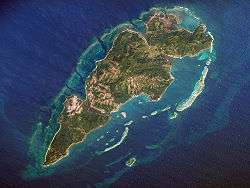
Guanaja is the second largest and is even more mountainous than Roatan. "Guanaja presents a mixture of the topographic and geologic features that characterize the two other large islands. This island is roughly divided into three sections by a series of hilltops, the highest of which rises to over 350 m above sea level, the highest elevation of the Bay Islands. These hilltops include important deposits of granite, marble, and serpentine.[9]" "In between these hills are moderately-sized alluvial plains that cut across these deposits, which have been densely populated since prehistory."[10]
Utila is third in size and is characterized by low mangrove swamps and a few small, low hills on its eastern end; the soils on this island are surprisingly fertile, perhaps owing to the islands's flat topography as well as volcanic tuffs and basalt lavas through coralline limestone.[9]
Barbareta, Morat, and the Hog Islands are all small and rugged.[7] "Barbareta, though also a small island, is nevertheless highly distinctive in that it contains several hilltops, the tallest of which reaches a height of 143 m above sea level. Barbareta also has the largest deposit of serpentine in the Bay Islands, which covers roughly one third of the island."[9]
"Morat is the smallest and flattest of the Bay Islands and is composed of a single ridge with two small hilltops",[7] "which are composed mainly of sedimentary rocks, with some serpentinite intrusions."[9]
"There are no rivers on any of the islands and only a few small streams, often terminating in the many mangrove swamps. Springs of cool water are rather numerous. Roatan is marked by a number of salt-water lagoons or drowned valleys, which form a system of interior waterways on the south side." [7]
History
Discovery
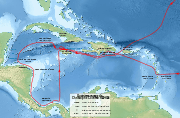
The Bay Islands, "this name was applied to the islands of Roatan, Guanaja, Barbareta, Helena, Morat, and Utila, in the bay of Honduras, since their organization as a colony of the British crown, in the year 1850."[11]
They were anciently known as Las Guanajas, from Guanaja, first seen by Christopher Columbus in his 4th and last voyage to the New World, on July 30, 1502. The Admiral named it 'Isle of Pines', and claimed it for Spain.[12] It was from this island that he then encountered the coast of the American continent, on which he landed on the 14th of August following, at the point now called Punta Castilla de Trujillo.[13]
"At the time of their discovery, these islands were occupied by a large population of Pech Indians, considerably advanced in civilization, who kept up a commerce, through the means of large and well equipped boats, not only with the mainland of Honduras, but also with Yucatan, and, it is alleged, with Jamaica."[11]
Notwithstanding, the Spanish Laws prohibited slavery, governors interested in traffic labeled the Indians, cannibals, hostile and opposed to Christianity. Based on this information, the Queen of Spain did not hesitate to issue a decree, granting license to the Spaniards to capture and sell the islanders.
Due to this inhuman decision, in 1516, Diego Velasquez, governor of Cuba, authorized several companies aiming to serve on the Indian slave trade. "For 20 years after the discovery of these islands they were subjected to repeated attacks from the Spaniards of Cuba, who fitted out expeditions against them for the capture of prisoners for slaves."[11] "Their population was in consequence greatly and rapidly reduced. When Cortes reached [Trujillo] however, in his famous march into Honduras, the remaining population sent messengers to him to solicit his protection, which he at once extended, driving off the vessels which came for prisoners, notwithstanding they had licenses from the governor of Cuba."[11]
"For a century subsequent to this event, the islands do not appear to have attracted much attention. The power and enterprise of Spain were directed to wider and richer fields. They seem to have been quietly occupied by their inhabitants, and governed by the authorities of the province of Honduras, as dependencies of the port of Trujillo."[11]
Early history
.jpg)
"The first non-Spanish attempt at settling the Bay Islands was apparently under the leadership of William Claibourne of Virginia. Claibourne was granted a formal patent in 1638 by the Providence Company to establish a colony on the island of Roatán. This colony, although very short-lived," [12] "marked the beginning of English interest in the Bay Islands of Honduras, which continued for more than two hundred years."
"During this time, however, a number of freebooters of Dutch, English, and French nationality had begun raids on Spanish shipping and settlements in the Bay of Honduras. In 1639 the Dutch buccaneer Van Horne led raids against the Spanish-Indian settlements in the islands. He appears to have overlooked, or perhaps he simply spared, Claibourne's small English settlement which, it is believed, was in the vicinity of Port Royal."[12]
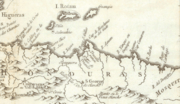
"In 1642, Port Royal on Roatán was occupied by English logwood cutters and settlers from what became British Honduras and now is known as Belize. These invaders conducted a number of successful piratical raids against the Spanish, and in 1650 four Spanish war ships, under one Francisco Villalva y Toledo, attempted to drive the buccaneers from Roatán. The latter, however, were so well fortified at Port Royal that the Spanish invaders were forced to withdraw to the mainland for reinforcements."[12]
"Outnumbering the defenders by more than 10 to one, the Spanish returned on March of 1650, and finally, after days of extremely hard fighting on the island, the Spanish succeeded in taking the heavy fortifications at Port Royal." [12] After driving out the buccaneers, the Spanish removed the few remaining Indians to the Central American mainland.
English Settlers in the Bay Islands
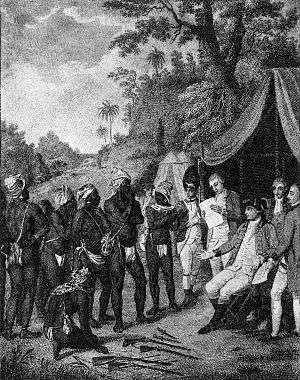
The first records indicating permanent English settlements in the Bay Islands show that Port Royal, on the island of Roatán, was again occupied in the year 1742. In this year the British made an attempt to gain possession of most of the Caribbean coast of Central America, and in doing so, rebuilt the old fort on Roatán.[12][14] "The archives at Belize record a Major Caulfield in command of Roatán as early as 1745. On August 2nd of that year, the Major wrote a letter to a Mr. Edward Trelawny, Governor of Jamaica, describing Spanish harassment of English settlements... These settlements appear to have been well established on the island of Roatán by 1775."[12]
The events which followed, so far as they concern these islands, are thus narrated by the Bishop Pelaez: "On the 24th of September, 1781, advices reached Truxillo, which were immediately communicated to the government at Comayagua, that certain negroes and others, to the number of about 300 men, had constructed three forts at the entrance of the principal port of the island of Roatan, armed with 50 guns, and that three armed. vessels cruised in the neighborhood, the object of the whole being to intercept the ships plying between the kingdom of Guatemala and Cuba. It was reported that these freebooters had 3000 barrels of provisions for their support, and that their object in holding the port was to make it a refuge for their vessels, which were no longer allowed to go-to Jamaica...When this information reached Guatemala, Viceroy Galvez, "made arrangements to expel the intruders."[14]
On the early morning of March, 2nd 1782, the Spanish...directed a well-coordinated attack against the English at Port Royal.[12] "After a heavy cannonade, detachments of the troops landed and opened regular trenches against the forts, which were so closely invested and hotly pressed that on the 16th of the month they surrendered at discretion. The lives of the defenders were spared, but all their dwellings, to the number of 500, were destroyed."[14] Six years later, in 1788, England completely evacuated all of her settlements in the Bay Islands as well as on the Miskito Shore.[14]
The islands then lay deserted of Europeans for almost fifteen years until 1797, when the English removed by force some 5,000 "Black Caribs" (a mixture of African Negro and Carib and Arawak Indians) from the Windward Island of St. Vincent, and marooned them on the then empty beaches of Port Royal on Roatán."[14] ...The deportees were taken first to the small island of Balliceaux, then to Bequia, both in the northern Grenadines. They were then dispatched by the H.M.S. Experiment to Roatan," under the command of Captain Barrett. They were landed on Roatán on a stormy day of February 25, 1797.[15][16] According to the Honduran historian, Durón, the British employed two men-of-war and a brigantine, landing the deportees in April, not February, in 1797.[12]
Colony of the Bay Islands | |||||||||
|---|---|---|---|---|---|---|---|---|---|
| 1852-1860 | |||||||||
 Flag | |||||||||
| Queen | |||||||||
• 1852-1860 | Queen Victoria | ||||||||
| Superintendent | |||||||||
| |||||||||
| Today part of | Honduras | ||||||||
Colony of the Bay islands
The English seem to have made no other demonstration on the islands during the 18th century. They remained in the undisturbed occupation of Spain.[12]"In 1821, when the Central American provinces achieved their independence, the islands were under the jurisdiction of the state of Honduras. This state of things continued until May, 1830, when the superintendent of the British establishment of Belize, as a measure of coercion against the republic, which had refused to surrender certain runaway slaves, made a descent on Roatan and seized it on behalf of the British crown. The federal authorities remonstrated, and the act was disavowed by the British government." [14]
"The superintendents of Belize, however, seem to have kept a longing eye on the islands, and to have watched for a pretext to place them under their own jurisdiction. In 1838 their wishes were in part gratified. A party of liberated slaves...of the Grand Cayman islands, came to Roatan to settle. Col. Loustrelet, the commandant, apprised them that they could not do so without tho permission of the state government of Honduras."[14]
"A number applied for and obtained the requisite permission, and received grants of land. But another portion, incited by one or two white men among them, appealed, as British subjects, to the superintendent of Belize, Col. Macdonald, who immediately visited the island, in the British sloop-of war Bover, ran down the flag of Honduras, and, seizing Col. Loustrelet and his soldiers, landed them near Truxillo, and threatened them with death if they ventured to return."[14]
The republic of Central America had meantime been dissolved, and the feeble state of Honduras was left alone to contest these violent proceedings. Her government remonstrated energetically, but without obtaining redress; and finally, in 1844, the British government instructed Mr. Chatfield, consul-general, to apprise the Honduras authorities, that "when Col. Macdonald hauled down the flag of that state in Roatan, it was by order of the British government..no act of sovereignty followed on the proceedings of Macdonald. Meanwhile the Cayman islanders continued to emigrate to Roatan, and, in 1848, the population numbered upward of 1,000.[14]
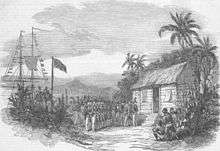
A small party in the island favorable to British interests, who were active in their efforts to secure English protection. "When visited by Capt. Mitchell, E. N., in 1850, he describes them as "electing their own magistrates, by universal suffrage," and "quite ignorant under what government they are placed." A Mr. William Fitzgibbon was chief justice, and acting chief magistrate. Some time in this year, a petition was drawn up by the British party, addressed to the governor of Jamaica, asking him to name magistrates and assume supreme authority in the island.[14]
Acting on this petition, Capt. Jolly, in H. B. M.'s ship-of-war Bermuda, was sent to the islands, who called a meeting of the inhabitants, and declared them under the sovereignty of the United Kingdom. Chief Justice Fitzgibbon protested against the whole proceeding...In spite of this protest, however, and backed by the guns of the Bermuda, the authorities appointed by Sir Charles Grey were duly installed in the islands. Two years after this occupation, on March 20, 1852, a royal warrant was issued, constituting the islands a colony, under the title of "colony of the Bay islands," of which proclamation was made in Roatan, by Col. Woodehouse, superintendent of Belize, Aug. 10, 1852.[14]
Cession of the Colony to Honduras
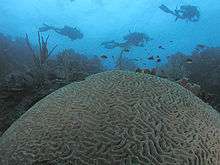
The proclamation of these islands as a British colony, attracted immediate attention in the United States, where it was universally regarded as a direct violation of the convention of July 5, 1850, known as the Clayton–Bulwer Treaty. This convention provides that "the governments of the United States and Great Britain, neither the one nor the other, shall over occupy, or fortify, or colonize, or assume or exercise any dominion over Costa Rica, Nicaragua, the Mosquito shore, or any part of Central America." [17]
The matter was brought under the attention of Congress, and the committee of foreign relations of the U.S. senate, after a full consideration, reported "that the islands of Roatán, Bonacca, Utila, etc, in and near the bay of Honduras, constitute part of the territory of the republic of Honduras, and therefore form a part of Central America; and, in consequence, that any occupation of these islands by Great Britain is a violation of the treaty of July 5, 1850." [17]
Expostulations to this effect were at once addressed by the American government to that of the United Kingdom, and an elaborate correspondence was carried on through the years 1854–1856, between Mr. Buchanan, American minister in London, and Lord Clarendon, on the subject, but without any satisfactory result. The United Kingdom hastily augmented her naval forces on the West India station, and her example was promptly followed by the United States; and, for a time, the peace of the two countries hung upon the discretion of a few naval commanders, acting under orders necessarily vague and indefinite.[17]
At this critical moment the government of Honduras despatched a minister to London, who took the ground that the question at issue was one that primarily concerned Honduras, and he demanded the surrender of the islands, equally as a measure of justice to that republic, and as a means of withdrawing a dangerous issue between the United States and the United Kingdom, upon which each had committed itself beyond the power of receding.[17]
At a convention held in Guatemala on April 30, 1859, the United Kingdom, under a great deal of pressure from the United States, agreed to surrender the Bay Islands and the Miskito Coast of both Honduras and Nicaragua, if allowed complete freedom of action in the territory known at that time as British Honduras. This solution was regarded with favor by both parties, and a convention was entered into between the United Kingdom and Honduras, whereby the Bay islands were placed under the sovereignty of the latter state, with the reservation of trial by jury, freedom of conscience, etc., to the actual inhabitants.[12]
The principles of this convention were accepted by Honduras, but some of its details were viewed with disfavor by the legislative assembly, and it was returned to London for certain modifications, which, it is understood, have been made, in which case no long time can elapse before the "colony of the Bay islands" will cease to exist, and the islands themselves again pass under tho sovereignty of Honduras.[17]
Many of the English settlers disagreed with this resolution. They sought the help of American filibuster William Walker in order to put pressure on the British government to keep the islands. Walker who in 1857 had been deposed from the presidency of Nicaragua, by a Central American army, decided to assist them. Walker arrived in Honduras, landed in Trujillo with one hundred men, but his efforts to help the English settlers, were in vain. Walker was captured by Captain Nowell Salmon who turned him over to Honduran authorities. He was prosecuted and sentenced to die before a firing squad. His execution took place at 8 am, on September 12, 1860.
Citizenship
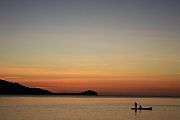
The Government of Honduras was heavily embroiled with troubles on the mainland, and had little interest in her newly won possessions some 15 to 80 kilometres (10 to 50 mi) off her northern shore. Honduras took no action at all until April 12, 1861, when her Minister of Foreign Affairs sent a brief note to a Mr. Hall, then British Consul to Honduras. This note informed Hall that Honduras was not yet prepared to take possession of the Bay Islands, and requested that England remain patient.[12]
On May 23 of 1861, however, British patience ran out. Belize demanded that the Commandant of Trujillo visit Roatán in the near future to take over the sovereignty of the colony, and on June 1, 1861, after having been a British Colony for less than nine years, the Bay Islands became the "Departamento de las Islas de la Bahía", under the struggling Republic of Honduras.[12]
It was not until 1902, a year after the death of Queen Victoria, that many of the islands' English population realized that their assumed British nationality and claims to British protection were no longer valid.[12]
Jane Houlson wrote in 1934 that many islanders were still denying Honduran nationality (p. 68); and Peter Keenagh, an Englishman visiting the islands in 1938, wrote: "Since the ratification of the Treaty of Comayagua there has been a continual struggle between Islanders and Mainlanders. The island families, for many reasons, consider that their British stock is superior to the confusion of Spanish, Indian, and Negro blood which populates the mainland, and there has never been the slightest feeling of subjection".[18]
Up until the late 1950s visitors to the islands "noted that there were some residents there who still claimed British nationality, even though both Honduras and England agree that any person born in the islands subsequent to the treaty of 1861 are Honduran citizens."[12]
Campaign for British rule
As of 2018, some islanders still insist that they are British and demand the islands are returned to Britain. The local mayor of Roatán, Carson Dilbert, who is campaigning to bring British rule back to the islands, told a British tabloid, "I don't just feel British. I am British."[19] The oldest man of English descent on the islands, Nelson Jackson-McNabb, 90, said, "If Britain came back it would be very nice. It would be nice to meet the Queen. We’d like to invite her to come here so we can shake her hand and raise the flag." Ted Thomas, a community leader on St. Helene, called himself and his fellow islanders "the lost tribe of Britain."[19]
Economy
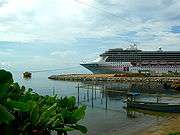
The economy of the Bay Islands has long relied almost entirely on the ocean, despite brief forays into the banana and pineapple exportation business in the late 19th century. Fishing has always been and continues to be the mainstay of the economy, with a fleet of some 400 commercial boats on all three islands, fishing mainly for shrimp, lobster, and conch. Overfishing has led to bans (vedas) during certain months of the year, but with only two inspectors, the several plants on Roatán pretty much buy whatever comes their way, whatever time of year it is. A modest boat-building industry, based particularly in Oak Ridge, has declined in recent years.[8]
Islander men frequently join on with the merchant marine or work on international cruise ships for several months of the year. This low-key existence began to change starting in the late 1960s, when tourists discovered the islands’ reefs, beaches, and funky culture. Since the late 1980s, the pace has picked up dramatically.
Nowadays, the Bay Islands serve "as the major anchor site for Honduras's growing tourism industry, accounting for approximately 28% of all tourism arrivals."[20] In 1990, an estimated 15,000 tourists came to the islands; by 1996 it was 60,000.[8] According to the Honduran Institute of Tourism, during the year 2010 the islands of Roatán received 803,102 cruise shippers, 373,273 more than those received in 2009 (an increase of 86.8%).[21] Total tourism receipts are estimated in the neighborhood of US$55 million annually.[20]
As such, the Bay Islands’ economy depends directly on two sectors – tourism and fisheries, representing approximately 50% of gross island product and both closely linked to the archipelago’s environment. All other activities provide services to these sectors, either directly as in the case of transportation or indirectly such as real estate and construction. The dynamic character of these sectors has led to accelerated growth over the last two decades, a phenomenon that has induced population growth rates approaching 8% annually, largely as a result of migration from various parts of Honduras and elsewhere.[20]
Municipalities
The department is divided into 4 municipalities (municipalidades):
| Municipality | description | Capital | Area (km²) | Population census 2012 |
|---|---|---|---|---|
| 1 Guanaja | Guanaja island | Bonacca town | 55.4 | 8,300 |
| Guanaja Island | Savannah Bight | 54 | 4300 | |
| Guanaja Cays | Bonacca town | 1.4 | 4000 | |
| 2 José Santos Guardiola | eastern Roatán island, JonesVille | Oak Ridge | 57.3 | 17,950 |
| east Roatán island | Oak Ridge | 50 | 17940 | |
| Barbareta Island | Playa Barbareta | 6 | 10 | |
| Helene Island, Morat, Pigeon Cays | 1.3 | 900 | ||
| 3 Roatán municipality | western Roatán island | Coxen Hole | 87.3 | 41220 |
| west Roatán island | Coxen Hole | 80 | 41060 | |
| Roatan cays | Antoney’s Cay | 1.2 | 40 | |
| Swan Islands | Harbor Bay | 3.5 | 10 | |
| Cayos Cochinos | Chachauate | 2.9 | 110 | |
| 4 Útila | Útila island | Utila Town | 49.3 | 4030 |
| Útila Island | Útila island | Utila Town | 47.9 | 3580 |
| Útila | Útila cays | Jewel Cay y Pigeon Cay | 1 | 450 |
| 5 Banco Vivorillo | Vivorillo Cay | Vivorillo Cay | 0.2 | 2 |
| Bobel Cay | Bobel Cay | Bobel Cay | 0.02 | 0 |
| Cayo Sur | Cayo Sur | Cayo Sur | 0.02 | 0 |
| Savanna Cay | Savanna Cay | Savanna Cay | 0.01 | 0 |
| Vivorillo Cay | Vivorillo Cay | 0.05 | 2 | |
| arrecifes de la media luna and more cays | media luna Cay | 0.05 | 0 | |
| Islas de la Bahia | incl. Swan Islands and Cayos Cochinos | Coxen Hole | 248.9 | 71500 |
See also

- Islas de la Bahia
- List of islands in the Caribbean: Honduras
- Outline of Honduras
- Index of Honduras-related articles
- List of cities in Honduras
- List of places in Honduras
- Cayman Islands
- Archipelago of San Andrés, Providencia and Santa Catalina
- Corn Island
see also, William V. Davidson, Historical Geography of the Bay Islands. Birmingham: Southern University Press. 1974 and other edition.
References
- "Sub-national HDI - Area Database - Global Data Lab". hdi.globaldatalab.org. Retrieved 2018-09-13.
- "Consulta Base de datos INE en línea: Censo de Población y Vivienda 2013" [Consult INE online database: Population and Housing Census 2013]. Instituto Nacional de Estadística (INE) (in Spanish). El Instituto Nacional de Estadística (INE). 1 August 2018. Retrieved 2018-09-13.
- https://hondurastravel.com/blog/bay-islands-flag/
- https://www.britishempire.co.uk/maproom/bayislands.htm
- https://hondurastravel.com/honduras-history/british-honduras-colonial-flag/
- Central American English Central American English, By John A. Holm, Geneviève Escure, Elissa Warantz. Central American English Volume I, 1983. Retrieved March 2, 2013.
- Duncan Strong, William (1935). "Archeological Investigations in the Bay Islands, Spanish Honduras". Smithsonian Institution. Retrieved March 2, 2013.
- Chris Humphrey, Amy E. Robertson (2009). "Moon Handbooks: Honduras & the Bay Islands". Perseus Books Group. Retrieved March 3, 2013.
- McBirney, A, and Bass, N. 1969. Geology of Bay Islands, Gulf of Honduras. In Tectonic Relations of Northern Central America, McBirney ed. Wisconsin: The Collegiate Press.
- "The Clash of Heritage and Development on the Island of Roatán, by Alejandro Figueroa". University of Florida. 2011. Retrieved March 2, 2013.
- George Ripley, Charles A. Dana (1867). "Moon Handbooks: Honduras & the Bay Islands". Retrieved March 5, 2013.
- David K. Evans (1999). "A Brief History of The Bay Islands". aboututila. Retrieved March 5, 2013.
- "Destinos Trujillo". hondurastips. Honduras. 2013.
- Squier, E.G. (1858). The States of Central America. New York: Harper & Brothers. pp. 615–616. Retrieved March 9, 2013.
After a heavy cannonade, detachments of the troops landed and opened regular trenches against the forts.
- Conzemius, Eduard.1928. Geology of Bay Islands, Gulf of Honduras. In Ethnographical Notes on the Black Carib (Garif). American Anthropologist April–June, 1928 Vol. 30 (2): 183-205
- Tennessee Anthropologist. Tennessee Anthropological Association. 1982. Retrieved March 9, 2013.
- Ripley, George (1867). Bay Islands. New York: The new American cyclopaedia: a popular dictionary of general. pp. 762–763. Retrieved April 6, 2013.
- "Mosquito coast: an account of a journey through the jungles of Honduras". Peter Keenagh. Honduras. 1938.
- "'Lost tribe' of Britons cut off on tiny island marks Royal Wedding". Mail Online. 12 May 2018. Retrieved 23 February 2019.
- Document of the Inter-american Development Bank. Retrieved March 2, 2013.
- "Informe de llegada de cruceristas a Honduras en 2010". Honduran Institute of Tourism. Honduras. 2009.
.svg.png)